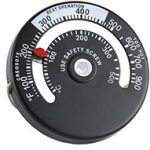As we are now in to the burning season and we find many customers are relatively new to wood burning I would like to offer some advice in burning kiln dried logs safely and efficiently.
 The aim is to get your stove above 250 degrees Fahrenheit as quickly as possible within the optimal temperature range for complete combustion, and then maintain an efficient clean burning fire.
The aim is to get your stove above 250 degrees Fahrenheit as quickly as possible within the optimal temperature range for complete combustion, and then maintain an efficient clean burning fire.
Avoiding creosote build-up
A very slow-burning fire in a modern, airtight stove with vents damped/closed down too much produces flue temperatures in the 100-200 degree Fahrenheit range.
These low temperatures do not sufficiently carry all of the unburned, combustible gases into the atmosphere. Instead, they condense along the walls of the stovepipe and your chimney as creosote.
This is why your fire must consistently produce enough heat to remove these gases as your logs burn and why it’s important to bring your initial temperature up quickly.
Tips for building your fire and using your vents to supply enough oxygen
Building and maintaining an effective fire requires burning the right amount of fuel, good fire-building practices and oxygen control using your vents. Obtain the best efficiency from your wood burning stove by following these practical steps:
- Always use kiln dried logs in your stove, never part-seasoned or damp wood
- Open all air vents to begin
- Start fires with firelighters and dry kindling – allow 5-10 minutes for the kindling to burn fiercely warming your flue and creating a strong draw before adding *any* logs
- Burn hot, bright fires and start with a few smaller logs
- Arrange your logs in such a way that allows air between, without overfilling your stove
- Keep your air vents fully open and do not reduce until your stove is operating higher than 300 degrees Fahrenheit for at least 15 minutes, then do so gradually at intervals – this will slow the burn and ensure more heat remains within your stove and less escapes up your flue. Closing your vents before this will starve your fire of oxygen during the warm-up phase and delay complete combustion – wait until significant heat can be felt from your stove before reducing airflow, especially when burning ash or oak logs. Never completely close your vents or attempt to close them too far and always re-assess how your fire is burning and adjust when necessary
- Let the fire burn down to glowing embers before reloading or until your flue temperature begins to drop toward 300 degrees Fahrenheit if you have a stove thermometer
- Reload by adding at least 2 logs each time – avoid adding one log at a time and opening your door too frequently as this will drop the temperature of your stove
- Open your vents slightly for a short period after adding more logs to help combustion and then reduce slightly after a few minutes
- Never leave your stove damped down heavily overnight – this will lead to hours of incomplete combustion and is the single biggest cause of creosote build-up. Instead, open your vents before going to bed so your fire burns clean overnight
- Have your chimney or flue swept before the start of each season to remove any deposits – if you follow these guidelines, your chimney sweep will be delighted and commend you on your skills and choice of logs!
- Install a carbon monoxide alarm and place it high up in your room 15cm below ceiling height. Make sure any alarm you buy is marked to EN 50291 and has the British Standards Kitemark
For safely operating your stove within the optimum temperature range to avoid incomplete combustion, consider purchasing if you haven’t already our Safety Essentials Pack which includes the following:
- Stove Flue Pipe Thermometer
- Safety Rated Stove Gloves
You can
read more and buy this pack on it’s own online – it will arrive by parcel courier within a few working days and is a good investment to ensure your fires are burning safe, efficiently and clean.
 Stove thermometers generally attach to your flue pipe by a magnet mounted on the rear, and provide instant feedback in how hot your fire is burning.
Stove thermometers generally attach to your flue pipe by a magnet mounted on the rear, and provide instant feedback in how hot your fire is burning.
